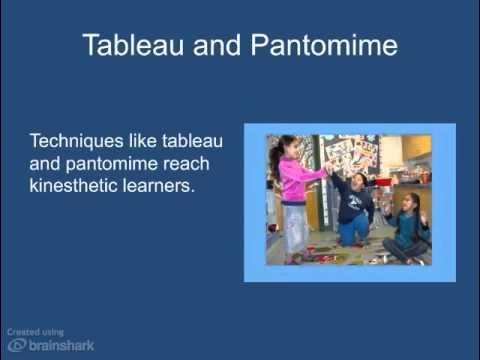ARTES TEATRO Situacion y Ficcion
Summary
TLDRThis educational video focuses on introducing first-grade students to the fundamentals of theater arts. It explores how real and fictional stimuli influence actors' physical and emotional responses on stage. Students engage in activities such as responding to a balloon stimulus, both real and imagined, to better understand how imagination and body awareness shape a performance. The class also highlights improvisation, collaboration, and expressing emotions through different tones and movements. Ultimately, the lesson demonstrates how everyday situations can transform into engaging theatrical storytelling through creativity and teamwork.
Takeaways
- 😀 Theater can transform everyday situations or elements into fictional narratives that are performed on stage.
- 😀 Fiction is a literary construction where events or characters are invented to tell a story, existing in an imaginary world.
- 😀 The combination of reality and fiction in theater allows for a dynamic exploration of different narrative possibilities.
- 😀 Actors in theater respond to physical or fictional stimuli presented on stage, engaging with the performance actively.
- 😀 Physical warm-up exercises help actors prepare their bodies to react to real and imagined stimuli.
- 😀 An imagined object, like an imaginary balloon, can serve as a fictional stimulus, demonstrating how imagination can influence physical responses.
- 😀 A stimulus is an agent, condition, or energy that provokes a reaction from an organism, and in theater, it drives character actions.
- 😀 Theatricality occurs when fiction is brought to life through performance, making the audience an active participant in the story.
- 😀 Emotional expression and physical movements in response to fictional stimuli vary, demonstrating different ways to convey the same phrase or situation.
- 😀 Improvised scenes allow actors to explore how a single line or situation can be expressed in countless ways, showing the power of creativity in storytelling.
- 😀 Imagination and communication between actors are essential to responding to fictional stimuli, shaping the narrative and performance together.
Q & A
What is the main difference between reality and fiction in theater?
-In theater, reality refers to situations or elements from everyday life that can be brought to the stage, while fiction involves invented characters and events, creating an imaginary world for the audience.
How does fiction function in literature and theater?
-Fiction serves as a literary construct where characters and events are invented, often with the goal of telling a story that exists within an imaginary world. It is a key tool for both literature and theater.
What is the role of the body when responding to a physical or fictitious stimulus in theater?
-Actors use their bodies to respond to both physical and fictitious stimuli. A physical stimulus, like a balloon, prompts a direct reaction, while a fictitious one, like imagining a balloon, triggers a response shaped by the actor's imagination and body awareness.
What was the purpose of the balloon activity in the class?
-The balloon activity was designed to help students practice responding to both real and imaginary stimuli, allowing them to explore how physical reactions can be triggered by different types of stimuli, real or imagined.
What is meant by a 'fictitious stimulus' in the context of this lesson?
-A fictitious stimulus refers to a situation or object that exists purely in the actor's imagination, such as an imagined balloon, and it still elicits a response from the actor, demonstrating how imagination can shape performance.
Why is responding to stimuli important in theater?
-Responding to stimuli is important because it helps actors create a dynamic and believable performance. Whether the stimulus is real or imagined, it allows the actor to engage with the scene and build a narrative through their reactions.
What is theatricality, and how does it relate to the audience?
-Theatricality occurs when fiction is brought to life on stage, allowing the audience to become active participants in the story. It bridges the imaginary world of the play with the audience's real-world experiences, making them part of the performance.
How did the class explore the phrase 'No, impossible, I can't believe it'?
-The class explored this phrase by experimenting with different emotions, rhythms, and intensities. They used varied vocal expressions and body language to convey different feelings like surprise, anger, or disbelief.
How does improvisation contribute to creating a scene in theater?
-Improvisation in theater allows actors to spontaneously respond to the unfolding action on stage. This helps in constructing the scene, as the actors' reactions and creativity build the narrative in real-time.
What did the teacher aim to achieve by having students work in teams to interpret a situation?
-The teacher wanted students to collaborate and creatively express the phrase 'No, impossible, I can't believe it' through different emotional and physical responses, highlighting the variety of ways one can react to a given situation.
Outlines

Этот раздел доступен только подписчикам платных тарифов. Пожалуйста, перейдите на платный тариф для доступа.
Перейти на платный тарифMindmap

Этот раздел доступен только подписчикам платных тарифов. Пожалуйста, перейдите на платный тариф для доступа.
Перейти на платный тарифKeywords

Этот раздел доступен только подписчикам платных тарифов. Пожалуйста, перейдите на платный тариф для доступа.
Перейти на платный тарифHighlights

Этот раздел доступен только подписчикам платных тарифов. Пожалуйста, перейдите на платный тариф для доступа.
Перейти на платный тарифTranscripts

Этот раздел доступен только подписчикам платных тарифов. Пожалуйста, перейдите на платный тариф для доступа.
Перейти на платный тарифПосмотреть больше похожих видео

40 soal latihan seni budaya (Seni Teater) beserta jawaban dan pembahasan #RuangBelajarSeniBudaya

Informal Theatre and Creative Drama

VIDEO PEMBELAJARAN SENI BUDAYA KELAS 8 SEMESTER 1 BAB 1 SENI RUPA

Latihan Soal PTS/UTS Bahasa Inggris kelas 1 SD Semester 1 Tahun 2023

Seni Budaya Kelas 11 - Seni Teater Modern (1/2) - SMA Doa Bangsa | M. Alief Syahid Saputra, S.Pd.

[Video 3] Prakarya Kelas 8 Semester 2 - Bab 4. Pengolahan Bahan Pangan Setengah Jadi
5.0 / 5 (0 votes)
